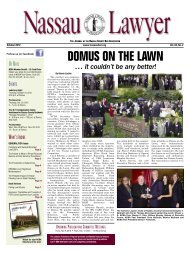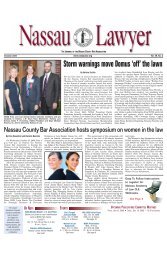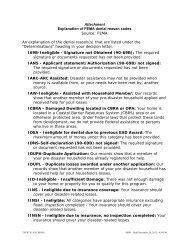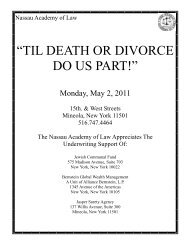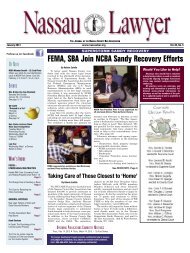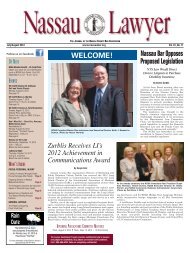770 N.Y.S.2d 421 Page 12 A.D.3d 780, 770 N.Y.S.2d 421, 2003 N.Y. Slip Op. 19961(Cite as: 2 A.D.3d 780, 770 N.Y.S.2d 421)Westlaw Delivery Summary Report for DANIELS,JEFFREYDate/Time <strong>of</strong> Request:Wednesday, October 21, 2009 17:33 EasternClient Identifier:NALDatabase:NY-CSCitation Text: 770 N.Y.S.2d 421Lines: 170Documents: 1Images: 0The material accompanying this summary is subject to copyright. Usage is governed by contract with ThomsonReuters, West and their affiliates.Supreme Court, Appellate Division, Second Department,New York.GRACE PLAZA OF GREAT NECK, INC., respondent,v.Maxine HEITZLER, appellant.Dec. 29, 2003.Background: Nursing home brought action againstfamily member <strong>of</strong> resident, seeking to recover balanceallegedly due to it for resident's care based onclaim that resident's transfer <strong>of</strong> personal injury litigationproceeds to family members were fraudulentconveyances to avoid payment <strong>of</strong> debt under Debtorand Creditor <strong>Law</strong>. The Supreme Court, QueensCounty, Dye, J., denied family member's motion forsummary judgment dismissing the complaint, and sheappealed.Holdings: The Supreme Court, Appellate Division,held that:(1) resident was not insolvent within meaning <strong>of</strong>Debtor and Creditor law, so as to support that herconveyances <strong>of</strong> portion <strong>of</strong> personal injury settlementproceeds to family members were fraudulent conveyancesmade with intent to defraud nursing home;(2) resident's transfers could not be deemed fraudulentas to creditors by having been made without consideration,so as to support nursing home's claim thatresident intended to incur debts beyond her ability topay as they matured; and(3) there was no basis to set aside resident's transfers,in absence <strong>of</strong> evidence that they were made with actualintent to hinder, delay, or defraud nursing homeas present or future creditor.Order reversed; motion granted.West Headnotes[1] Fraudulent Conveyances 57(1)186k57(1) Most Cited CasesNursing home resident was not insolvent withinmeaning <strong>of</strong> Debtor and Creditor law, so as to supportthat her conveyances <strong>of</strong> portion <strong>of</strong> personal injurysettlement proceeds to family members were fraudulentconveyances made with intent to defraud nursinghome; resident retained cash assets <strong>of</strong> over $342,700after intra-family transfers <strong>of</strong> settlement proceeds andcontinued to receive pension and social securitybenefits, and there was no evidence that resident hadoutstanding debts owed to nursing home or any othercreditor when transfers to family members weremade. McKinney's Debtor and Creditor <strong>Law</strong> §§271, subd. 1, 273.[2] Fraudulent Conveyances 58186k58 Most Cited CasesTransfers <strong>of</strong> personal injury settlement proceeds thatnursing home resident made to family members couldnot be deemed fraudulent as to creditors by havingbeen made without consideration, so as to supportnursing home's claim that resident intended to incurdebts beyond her ability to pay as they matured; therewas no evidence that resident had good indicationthat funds she retained from settlement proceedswould be insufficient to pay for nursing home careduring three-year period she would be required to© 2009 Thomson Reuters. No Claim to Orig. US Gov. Works.
770 N.Y.S.2d 421 Page 22 A.D.3d 780, 770 N.Y.S.2d 421, 2003 N.Y. Slip Op. 19961(Cite as: 2 A.D.3d 780, 770 N.Y.S.2d 421)wait in order to be eligible for Medicaid assistancebased on rates charged by nursing home at time thattransfers were made. McKinney's Debtor and Creditor<strong>Law</strong> § 275.[3] Fraudulent Conveyances 64(2)186k64(2) Most Cited CasesThere was no basis to set aside transfers that nursinghome resident made to family members following herreceipt <strong>of</strong> personal injury settlement proceeds, in absence<strong>of</strong> evidence that nursing home resident madetransfers with actual intent to hinder, delay, or defraudnursing home that subsequently sought to recoversum owed to it for resident's care as present orfuture creditor; resident retained assets reasonablycalculated to cover cost <strong>of</strong> her care for three-yearwaiting period until she became eligible for Medicaidbenefits. McKinney's Debtor and Creditor <strong>Law</strong> § 276.**422 Joan M. Sec<strong>of</strong>sky, New York, N.Y., for appellant.Abrams, Fensterman, Fensterman, Flowers & Eisman,LLP, Lake Success, N.Y. (Nancy J. Klein andAngela C. Bellizzi <strong>of</strong> counsel), for respondent.GABRIEL M. KRAUSMAN, J.P., LEO F. McGIN-ITY, ROBERT W. SCHMIDT and REINALDO E.RIVERA, JJ.*780 In an action, inter alia, to set aside a conveyancepursuant to Debtor and Creditor <strong>Law</strong> article 10,the defendant appeals from an order <strong>of</strong> the SupremeCourt, Queens County (Dye, J.), dated January 8,2003, which denied her motion for summary judgmentdismissing the complaint.ORDERED that the order is reversed, on the law,with costs, the motion is granted, and the complaint isdismissed.On January 8, 1996, the defendant's 81-year-oldmother, Estelle Witt, entered a nursing home ownedand operated by the plaintiff. Approximately ninemonths later, in September 1996, Mrs. Witt receivedthe sum <strong>of</strong> $659,532 in settlement <strong>of</strong> a medical malpracticeaction. It is undisputed that Mrs. Witt gaveover $350,000 <strong>of</strong> the settlement funds to the defendantand other family members. However, even aftertransferring these funds, Mrs. Witt retained over$342,700 in various bank and brokerage accounts.Mrs. Witt left the plaintiff's facility in November1999, and moved to a nursing home in Texas. Approximatelythree months later, the plaintiff commencedthis action, inter alia, to recover a balance <strong>of</strong>$26,610.73 allegedly due for Mrs. Witt's care, uponthe theory that the September 1996 fund transfers tothe defendant and other family members constitutedfraudulent conveyances pursuant to Debtor andCreditor <strong>Law</strong> §§ 273, 275, and 276. After discoverywas conducted, the defendant moved for summaryjudgment, contending that the September 1996 fundtransfers were not fraudulent conveyances becausethey did not render her mother insolvent, and werenot made with the intent to defraud creditors. *781The Supreme Court denied the motion, concluding,inter alia, that there were issues <strong>of</strong> fact as to whetherMrs. Witt had a **423 "good indication" <strong>of</strong> futureinsolvency when she transferred funds to her familyin September 1996, and whether she made the transferswith intent to defraud. We now reverse.[1] Pursuant to Debtor and Creditor <strong>Law</strong> § 273, aconveyance made by a person who will be renderedinsolvent thereby is fraudulent as to creditors, withoutregard to his or her actual intent, if the conveyanceis made without fair consideration. An individualis "insolvent" within the meaning <strong>of</strong> the Debtorand Creditor <strong>Law</strong> when "the present fair saleablevalue <strong>of</strong> his [or her] assets is less than the amountthat will be required to pay his [or her] probable liabilityon * * * existing debts as they become absoluteand matured" (Debtor and Creditor <strong>Law</strong> §271[1] ). Here, in support <strong>of</strong> her motion for summaryjudgment, the defendant submitted uncontrovertedevidence that her mother, now deceased, retainedcash assets <strong>of</strong> over $342,700 after the subject intrafamilytransfers, and that she continued to receive apension and social security benefits. Furthermore,there is no evidence that Mrs. Witt had outstandingdebts to the plaintiff nursing home, or any othercreditor, when the transfers were made in September1996. Under these circumstances, the transfers didnot render Mrs. Witt insolvent (see St. Teresa's NursingHome v. Vuksanovich, 268 A.D.2d 421, 702N.Y.S.2d 92), and thus were not fraudulent conveyanceswithin the meaning <strong>of</strong> Debtor and Creditor<strong>Law</strong> § 273.[2] Furthermore, the September 1996 transfers cannotbe deemed fraudulent as to creditors pursuant toDebtor and Creditor <strong>Law</strong> § 275. Debtor and Creditor<strong>Law</strong> § 275 provides that a conveyance made without© 2009 Thomson Reuters. No Claim to Orig. US Gov. Works.
- Page 1 and 2:
Nassau Academy of LawCLE Live Class
- Page 3 and 4:
McKinney's Debtor and Creditor Law
- Page 5 and 6:
McKinney's Debtor and Creditor Law
- Page 7 and 8:
McKinney's Debtor and Creditor Law
- Page 9 and 10:
McKinney's Debtor and Creditor Law
- Page 11 and 12:
McKinney's Debtor and Creditor Law
- Page 13 and 14:
McKinney's Debtor and Creditor Law
- Page 15 and 16:
McKinney's Debtor and Creditor Law
- Page 17 and 18:
McKinney's Debtor and Creditor Law
- Page 19 and 20:
BAKER & HOSTETLER LLP45 Rockefeller
- Page 21 and 22:
usiness of defendant Bernard L. Mad
- Page 23 and 24:
BACKGROUND, THE TRUSTEE, AND STANDI
- Page 25 and 26:
Madoff who received fraudulent tran
- Page 27 and 28:
ased on fictitious profits and for
- Page 29 and 30:
28. BLMIS funds were also used to p
- Page 31 and 32:
Madoff, and her niece, Shana Madoff
- Page 33 and 34:
42. Ruth Madoff was never an employ
- Page 35 and 36:
FIRST CAUSE OF ACTIONTURNOVER AND A
- Page 37 and 38:
66. At the time of each of the Two-
- Page 39 and 40:
Transfers; (b) directing that the S
- Page 41 and 42:
EIGHTH CAUSE OF ACTIONUNDISCOVERED
- Page 43 and 44:
TENTH CAUSE OF ACTIONDISALLOWANCE O
- Page 45 and 46:
111. Mrs. Madoff benefited from the
- Page 47 and 48:
WHEREFORE, the Trustee respectfully
- Page 49 and 50:
2(c)(3): (a) preserving the Subsequ
- Page 51 and 52:
302 B.R. 760 Page 1302 B.R. 760(Cit
- Page 53 and 54:
302 B.R. 760 Page 3302 B.R. 760(Cit
- Page 55 and 56:
302 B.R. 760 Page 5302 B.R. 760(Cit
- Page 57 and 58:
302 B.R. 760 Page 7302 B.R. 760(Cit
- Page 59 and 60:
302 B.R. 760 Page 9302 B.R. 760(Cit
- Page 61 and 62:
302 B.R. 760 Page 11302 B.R. 760(Ci
- Page 63 and 64:
302 B.R. 760 Page 13302 B.R. 760(Ci
- Page 65 and 66:
302 B.R. 760 Page 15302 B.R. 760(Ci
- Page 67 and 68:
302 B.R. 760 Page 17302 B.R. 760(Ci
- Page 69 and 70:
302 B.R. 760 Page 19302 B.R. 760(Ci
- Page 71 and 72:
394 B.R. 721 Page 1394 B.R. 721, 50
- Page 73 and 74: 394 B.R. 721 Page 3394 B.R. 721, 50
- Page 75 and 76: 394 B.R. 721 Page 5394 B.R. 721, 50
- Page 77 and 78: 394 B.R. 721 Page 7394 B.R. 721, 50
- Page 79 and 80: 394 B.R. 721 Page 9394 B.R. 721, 50
- Page 81 and 82: 394 B.R. 721 Page 11394 B.R. 721, 5
- Page 83 and 84: 394 B.R. 721 Page 13394 B.R. 721, 5
- Page 85 and 86: 394 B.R. 721 Page 15394 B.R. 721, 5
- Page 87 and 88: 394 B.R. 721 Page 17394 B.R. 721, 5
- Page 89 and 90: 394 B.R. 721 Page 19394 B.R. 721, 5
- Page 91 and 92: 394 B.R. 721 Page 21394 B.R. 721, 5
- Page 93 and 94: 397 B.R. 642 Page 2397 B.R. 642(Cit
- Page 95 and 96: 397 B.R. 642 Page 4397 B.R. 642(Cit
- Page 97 and 98: 397 B.R. 642 Page 6397 B.R. 642(Cit
- Page 99 and 100: 397 B.R. 642 Page 8397 B.R. 642(Cit
- Page 101 and 102: 397 B.R. 642 Page 10397 B.R. 642(Ci
- Page 103 and 104: 397 B.R. 642 Page 12397 B.R. 642(Ci
- Page 105 and 106: 397 B.R. 642 Page 14397 B.R. 642(Ci
- Page 107 and 108: 443 F.3d 180 Page 2443 F.3d 180(Cit
- Page 109 and 110: 443 F.3d 180 Page 4443 F.3d 180(Cit
- Page 111 and 112: 443 F.3d 180 Page 6443 F.3d 180(Cit
- Page 113 and 114: 443 F.3d 180 Page 8443 F.3d 180(Cit
- Page 115 and 116: 443 F.3d 180 Page 10443 F.3d 180(Ci
- Page 117 and 118: 443 F.3d 180 Page 12443 F.3d 180(Ci
- Page 119 and 120: Page 2257 A.D.2d 526, 684 N.Y.S.2d
- Page 121 and 122: Page 4257 A.D.2d 526, 684 N.Y.S.2d
- Page 123: Page 6257 A.D.2d 526, 684 N.Y.S.2d
- Page 127 and 128: Page 14 A.D.3d 495, 773 N.Y.S.2d 71
- Page 129: Page 34 A.D.3d 495, 773 N.Y.S.2d 71
- Page 132 and 133: 780 N.Y.S.2d 409 Page 29 A.D.3d 553
- Page 134 and 135: Page 134 A.D.3d 231, 824 N.Y.S.2d 3
- Page 136 and 137: Page 334 A.D.3d 231, 824 N.Y.S.2d 3
- Page 138 and 139: Page 2991 F.2d 31(Cite as: 991 F.2d
- Page 140 and 141: Page 4991 F.2d 31(Cite as: 991 F.2d
- Page 142 and 143: Page 6991 F.2d 31(Cite as: 991 F.2d
- Page 144 and 145: FRAUDULENT TRANFERENCESRonald M. Te
- Page 146 and 147: Nursing home case_ Transfer of pers
- Page 148 and 149: Sections 548 and 544 work in concer
- Page 150 and 151: U.S. Supreme CourtBFP v. Resolution
- Page 152 and 153: example, from net 15 to COD; or cha
- Page 154 and 155: Bankruptcy Code Section§ 548. Frau
- Page 156: Ron Terenzi is a founding partner a



